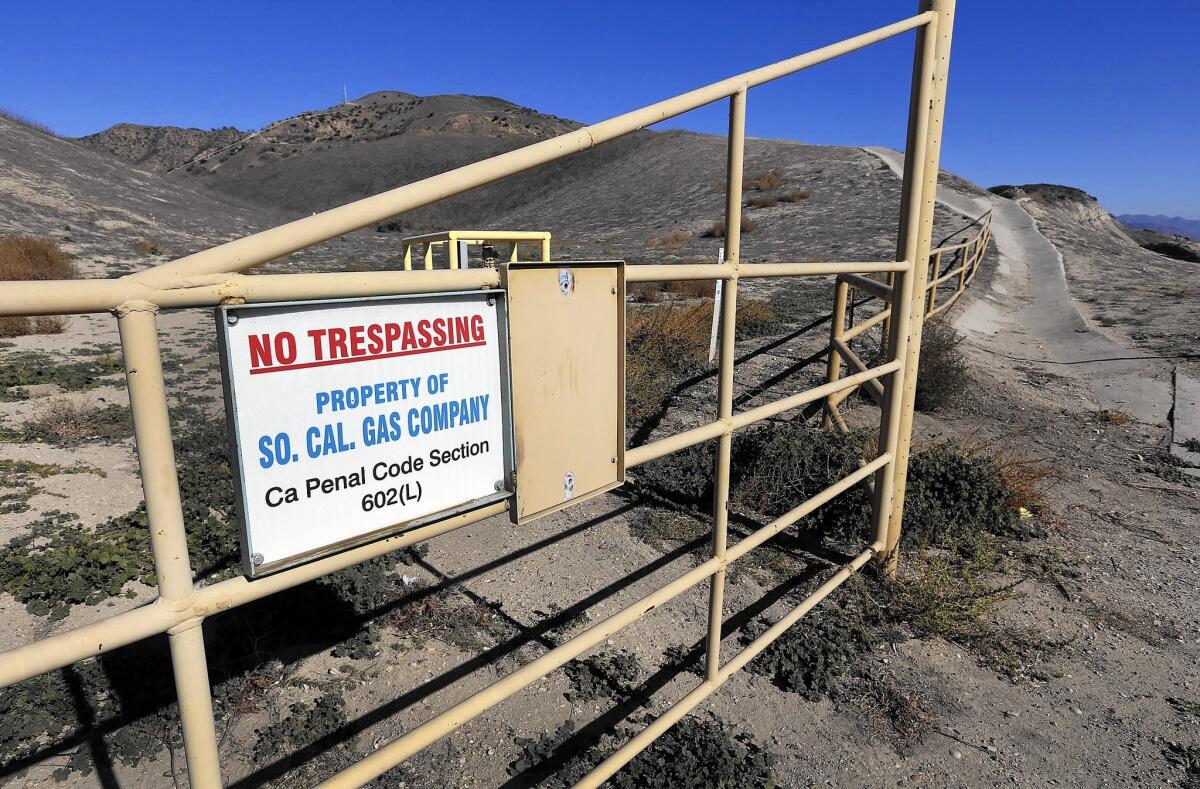Is the end in sight for the Porter Ranch-area gas leak?

A state official said Thursday that under the most favorable circumstances, the damaged well that has spewed environmentally damaging natural gas from a storage facility near Porter Ranch could be capped as early as the end of next week.
But the timeline, he cautioned, was fraught with variables.
Wade Crowfoot, a senior advisor to Gov. Jerry Brown, told those at a public meeting at Cal State Northridge that the relief well that is still being drilled was tentatively expected to intercept the leaking well as early as Monday.
After reaching the well at the Aliso Canyon Natural Gas Storage Facility, Southern California Gas Co.’s crews could then begin sealing the well in a process that could take “certainly not less than five days,” he said.
Crowfoot’s comments offered a more detailed timeline for stopping the leak than has the gas company, which reiterated in a statement issued Thursday night that it planned to stop the leak by the end of February, if not sooner.
“While we cannot confirm how long the process will take, we are working to do this as safely and expeditiously as possible,” said Kristine Lloyd, a spokeswoman for the utility.
The well, located in the largest underground natural gas storage facility west of the Mississippi River, has been leaking since Oct. 23 and has released about 80,000 metric tons of methane.
The gas and other odorants have prompted complaints of headaches and nosebleeds, and the leak has displaced residents from about 5,000 homes in Porter Ranch and surrounding communities.
Last month, Brown declared an emergency, and this week, Los Angeles County Dist. Atty. Jackie Lacey filed criminal charges against the utility, accusing it of releasing air contaminants and neglecting to report the emission of hazardous materials until three days after the leak began.
At the meeting, which is held regularly by a local committee, Crowfoot said that once the crews had intercepted the damaged well, they would begin pumping fluid and mud into the well to kill it.
Next, the concrete would be pumped into the well to plug it, and the concrete would have to cure and dry.
Then, state regulators would have to confirm the leak has actually stopped; a spokesman for the governor said the length of that process is unknown.
But the task of plugging the well about 1.6 miles below ground is mired in uncertainties: the relief well could miss its target; it could take a long time to pump in the mud and fluid; and the overall process may not stanch the leak, he said.
In the event that the first relief well fails, the gas company decided to drill a second relief well. Drilling on the second well is scheduled to begin Monday.
Gillian Wright, a gas company executive who also attended the meeting, told the visibly frustrated residents that Crowfoot’s timeline was “a tentative schedule,” not a definitive one.
“We are very close to the end of the leak; however, we are also in the most technically demanding phase of the work,” Wright said.
With the possible end of the leaking well in sight, the timeline for residents to return to home has emerged as another contentious issue.
The gas company and the L.A. city attorney’s office agreed in December that residents who relocated would return to their homes within 48 hours once authorities certify that the leak has stopped.
Los Angeles County Supervisor Michael D. Antonovich, however, wants residents to have additional time, and he is expected to introduce a motion Tuesday that expands the timeline to 30 days.
“This will provide adequate time for displaced residents to move their families and pets back into the community,” the supervisor’s motion said.
Gas company representatives and the city attorney’s office said they are already discussing an extension of the 48-hour provision.
For residents who chose to temporarily relocate, the gas company offered to pay as much as $7,500 a month for rent, $500 for utilities and $500 in moving expenses. Customers who remained in their homes were provided with air filters and weather stripping for their doors.
Also on Tuesday, representatives of the gas company, public health agencies, the Fire Department and the South Coast Air Quality Management District are expected to provide a status update on the gas leak to the Board of Supervisors.
Twitter: @MattHjourno
Times staff writer Alice Walton contributed to this report.
ALSO:
Time expires on claims for winning $63-million Lotto jackpot
BMX and X Games star Dave Mirra dies at 41 in apparent suicide
How are Muslims around the world reacting to Obama’s visit to a mosque?







